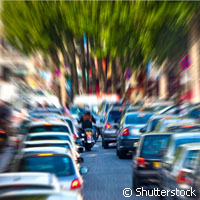Scientists find link between stroke risk and road traffic noise
People are at greater risk of stroke when they are exposed to increased road traffic noise, new research shows. Scientists in Denmark say people who are 65 years and older are at an even greater risk. The results of the study were recently published in the European Heart Journal. Researchers at the Institute of Cancer Epidemiology at the Danish Cancer Society in Copenhagen evaluated 51,485 participants and discovered that for every 10 decibels (dB) more noise, there is a 14% greater risk of having a stroke. Further evaluation revealed that people who are less than 65 years are not at increased risk of stroke, but the risk increased by more than a quarter for every 10dB of increased noise in road traffic. The data also showed indications of a threshold limit at around 60 dB, effectively triggering an even bigger risk of stroke. 'Our study shows that exposure to road traffic noise seems to increase the risk of stroke,' explained Dr Mette Sørensen at the Institute of Cancer Epidemiology. 'Previous studies have linked traffic noise with raised blood pressure and heart attacks, and our study adds to the accumulating evidence that traffic noise may cause a range of cardiovascular diseases. These studies highlight the need for action to reduce people's exposure to noise,' the project leader said. 'This is the first study ever to investigate the association between exposure to road traffic noise and risk of stroke, and, therefore, more research is needed before any firm conclusions can be made.' The team based their study on the 1993-1997 Danish 'Diet, Cancer and Health' cohort study that had a 57,053-strong sample aged between 50 and 64. The participants were from the Copenhagen and Aarhus areas. In this latest study, the researchers had access to subjects' medical and residential histories, and their average follow-up was 10 years. During this interim, 1 881 people suffered a stroke. Dr Sørensen and her team considered in their calculations the impact of air pollution, exposure to railway and aircraft noise, as well as a range of other confounding lifestyle factors like diet, smoking, and alcohol and caffeine consumption. They also found that information on the subjects and their area of residence were connected to a noise calculation programme that has been used to map noise levels in various locations across the Nordic region for a number of years. Under the programme, speed and traffic composition, as well as road type (e.g. rural highways, motorways) and surfaces, and the position and heights of people's homes above the roads were taken into account. The researchers said that 35% of people were exposed to noise levels greater than 60dB at the time they joined the study, and 72% resided at the same address throughout the study period. The lowest estimate for noise exposure was 40dB and the highest was 82dB, they pointed out. Commenting on the results, Dr Sørensen said: 'If we assume that our findings represent the true risk, and the association between traffic noise and stroke is causal, then an estimated 8% of all stroke cases, and 19% of cases in those aged over 65, could be attributed to road traffic noise. The population in this study, however, lived mainly in urban areas and is, therefore, not representative of the whole population in terms of exposure to road traffic noise. However, if we take the exposure distribution of all dwellings in Denmark into account, we find that about 600 new cases of stroke could be attributed to road traffic noise in Denmark each year. There are 5.5 million inhabitants in Denmark and a total of 12 400 new cases of stroke each year.' The study could only determine if there is a link between road traffic noise and higher risk of stroke, not whether the noise actually heightens risk because of its epidemiological nature.For more information, please visit: Institute of Cancer Epidemiology:http://www.cancer.dk/epi+research/European Heart Journal:http://eurheartj.oxfordjournals.org/
Countries
Denmark



